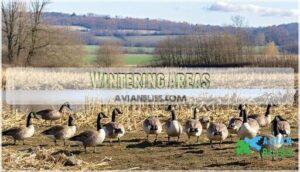This site is supported by our readers. We may earn a commission, at no cost to you, if you purchase through links.

These stunning birds feature distinctive crested heads, peachy-brown faces, and waxy red wing tips that give them their name.
They’re slightly larger than their cedar waxwing cousins and sport rusty undertail feathers with bold white wing markings.
Bohemian waxwings follow fruit crops in unpredictable patterns, sometimes appearing in huge numbers during winter irruptions when northern berry supplies run low.
Their social nature and fruit-focused diet make them fascinating subjects for understanding how birds adapt their movements to find food across vast landscapes.
Table Of Contents
- Key Takeaways
- Bohemian Waxwing Overview
- Habitat and Distribution
- Behavior and Diet
- Reproduction and Vocalizations
- Conservation and Human Interaction
- Frequently Asked Questions (FAQs)
- Where do Bohemian Waxwings live?
- What’s the difference between a Cedar Waxwing and a Bohemian Waxwing?
- Why are they called Bohemian Waxwings?
- What do Bohemian Waxwings do to survive?
- Is a cedar waxwing the same as a Bohemian waxwing?
- Are Bohemian waxwings rare?
- What are some interesting facts about Bohemian Waxwings?
- Where can I find Bohemian Waxwings?
- How long do Bohemian Waxwings typically live?
- Do Bohemian Waxwings have any unique adaptations?
- Conclusion
Key Takeaways
- You’ll recognize bohemian waxwings by their distinctive waxy red wing tips, crested heads, and larger size compared to cedar waxwings, making them easier to identify in the field.
- You can expect these nomadic birds to appear unpredictably in massive flocks during winter irruptions when northern berry crops fail, sometimes traveling thousands of miles from their usual range.
- You’ll find they’re highly social fruit-eaters that consume over 80% berries in winter, often eating twice their body weight daily while following food sources across northern forests.
- You should know their populations have declined 55% since 1970 due to habitat loss and climate change, though they’re still listed as "Least Concern" on the IUCN Red List.
Bohemian Waxwing Overview
You’ll recognize the Bohemian Waxwing by its larger size compared to the Cedar Waxwing and its striking crest that points backward.
This nomadic bird measures about 8 inches long with a wingspan reaching 14 inches, making it quite impressive when you spot one in your area.
Size and Measurements
Observing a bohemian waxwing reveals specific measurements that aid bird identification.
These striking birds measure 7-8 inches long with a wingspan variation of 13-14.5 inches.
Body mass ranges from 40-69 grams, showing considerable seasonal fluctuation.
Sexual dimorphism appears minimal in size, though males slightly exceed females.
Tail length spans 2.5-3 inches, while feather length varies across different body regions, creating their distinctive silhouette during birdwatching expeditions.
Color Pattern
You’ll spot the bohemian waxwing’s sleek gray-brown plumage with striking yellow tail tips and waxy red wing spots.
Their feather pigmentation creates subtle iridescence in sunlight.
Adult males show brighter color variation than females, particularly in their yellow markings.
Regional differences appear minimal across their range.
This distinctive waxwing plumage serves dual purposes – attracting mates while providing camouflage among tree branches during birdwatching encounters, showcasing its unique plumage.
Physical Characteristics
Beyond their striking colors, you’ll notice distinct physical features that help identify Bohemian Waxwings in the field.
These details set them apart from similar bird species:
- Plumage Details: Soft, silky feathers create their smooth appearance
- Crest Variation: Pointed head crest changes shape based on mood
- Masking Extent: Black eye mask extends from bill to behind eye
- Waxy Tips: Red waxy wing tips give the species its name
Their waxwing plumage adapts perfectly to their nomadic lifestyle across varied waxwing habitat.
These birds also exhibit distinctive beak adaptations for efficient fruit handling.
Distinguishing Features
You’ll notice the Bohemian waxwing’s signature waxy red tips on wing feathers that give this bird species its name.
These waxy tips appear like tiny red droplets on secondary flight feathers.
The bird’s black mask extends through the eye, though masking variation occurs between individuals.
Look for distinctive tail markings – a bright yellow terminal band across the tail tip.
The bill shape remains short and wide, perfect for their fruit-heavy waxwing diet.
Habitat and Distribution
You’ll find Bohemian Waxwings across the northern forests of North America and Eurasia during breeding season.
These nomadic birds move unpredictably based on food availability, sometimes appearing in large numbers far south of their usual range during winter months, exhibiting unpredictable behavior.
Breeding Range
You’ll find Bohemian Waxwings breeding across the northern forests of North America and Eurasia.
These migratory birds establish territories in remote wilderness areas where their waxwing diet thrives.
Their breeding range includes:
- Nesting Locations: Boreal forests of Alaska, western Canada, and northern Rocky Mountains
- Territory Size: Pairs defend small areas around nest sites, not large territories
- Breeding Success: Depends heavily on cone and berry crop availability
- Range Expansion: Climate impact may shift breeding areas northward over time
- Habitat Requirements: Mature coniferous forests with abundant food sources
These winter birds follow unpredictable bird migration patterns, making their breeding distribution somewhat fluid year to year.
Wintering Areas
During winter months, you’ll find Bohemian Waxwings in areas with abundant fruit sources. Their wintering destinations shift based on Food Availability and Climate Impact.
These nomadic wanderers follow food sources across vast distances, appearing unpredictably when berry crops fail in their northern territories.
These winter birds prefer regions with mountain ash berries, juniper, and crabapples. Urban Habitats increasingly support flocks when natural food becomes scarce.
They demonstrate how birds can adapt to urban environments when their natural habitats are limited.
| Region | Primary Food Sources | Typical Flock Size |
|---|---|---|
| Pacific Northwest | Mountain ash, juniper | 50-200 birds |
| Great Lakes | Crabapples, cedar berries | 20-100 birds |
| Urban Parks | Ornamental fruits, feeders | 10-50 birds |
| Boreal Edge | Birch seeds, dried berries | 100-500 birds |
Roosting Sites include dense conifers and sheltered areas.
Birdwatching tips: check fruiting trees in parks and neighborhoods. These locations offer prime birding locations for observing their fascinating bird behavior throughout winter.
Migratory Patterns
Bohemian Waxwings follow unpredictable Migration Triggers tied to berry crops and climate conditions. These stunning birds don’t stick to traditional Flyway Routes—instead, they pursue Irruptive Migration patterns that can take them thousands of miles from previous wintering spots.
Their irruptive winter behavior means their presence varies greatly year to year based on food availability.
Key Migration Facts:
- Timing varies – September through March peaks, influenced by northern breeding success
- Distance extremes – Some birds travel up to 6,000 kilometers between seasons
- Flock behavior – Groups of thousands move together for Winter Roosting safety
- Food-driven routes – Poor berry years trigger massive southern invasions
- Climate Impacts – Weather patterns increasingly affect traditional movement timing
These nomadic wanderers make birdwatching tips essential since rare bird sightings occur unpredictably. Their bird behavior includes rapid landscape scanning for fruit sources, making birding locations worthwhile even outside typical ranges.
Listen for their distinctive bird songs—high trills often announce incoming flocks before visual confirmation.
Preferred Habitats
You’ll find these remarkable fruiteating birds thriving in Boreal Forests across northern regions, where they feast on abundant berries.
They’ve mastered Habitat Adaptations that let them survive harsh conditions while seeking ideal Roosting Sites in dense conifers.
Their Elevation Preferences span from sea level to mountainous areas.
During irruptive years, they venture into Urban Habitats, delighting backyard birds enthusiasts at bird feeders.
Bird photography opportunities abound when flocks descend, their distinctive bird songs echoing through neighborhoods.
Behavior and Diet
If you’ve ever wondered what drives these nomadic birds through their daily lives, you’re in for a treat.
Bohemian Waxwings display fascinating social behaviors and have surprisingly varied diets that change with the seasons and available food sources, which makes their lifestyle quite varied.
Social Structure
You’ll observe these birds form tight-knit groups year-round.
Bohemian waxwings show minimal social hierarchy within winter flocks, instead operating as egalitarian bohemian communities.
Flock dynamics center on shared resources and mutual protection.
Notably, you can find waxwing themed merchandise online.
Unlike many fruit-eating birds that visit backyard bird feeders individually, these bohemian nomads maintain strong social bonds through sophisticated communication methods during both foraging and travel across their range.
Flocking Habits
You’ll notice these crested birds gather in flocks ranging from dozens to several hundred individuals.
Flock size depends on food availability and season. Unlike many species, Bohemian waxwings don’t establish strict social hierarchy within their colony.
Instead, they cooperate seamlessly while foraging. Large groups provide excellent predator evasion – more eyes scanning for threats.
Their roosting behavior shows remarkable coordination, with entire flocks moving together like flowing water across Bohemia’s landscapes. Supplementing their diet with winter bird feeders can help them survive harsh conditions.
Feeding Behavior
Three key Foraging Strategies guide these crested birds through their Winter Diet demands.
You’ll witness their efficient techniques as they search for diverse Food Sources to meet their Nutritional Needs.
- Opportunistic feeding – They adapt quickly when preferred foods become scarce
- Group coordination – Flocks share information about productive feeding locations
- Seasonal flexibility – Their diet shifts dramatically based on available resources
- Energy efficiency – They prioritize high-calorie foods for maximum benefit
- Timing patterns – Most active feeding occurs during early morning hours
These nomadic birds demonstrate remarkable adaptability in their feeding approach.
To guarantee proper nutrition, consider exploring options for supplemental waxwing bird food.
Bird conservation efforts often focus on maintaining diverse food sources.
According to MerriamWebster dictionary definitions, their behavior exemplifies true opportunism in nature.
Fruits and Berries
You’ll find that berries make up over 80% of these birds’ winter diet. They target sugar-rich rowan berries first for maximum Berry Nutrition.
Their unconventional lifestyle involves consuming twice their body weight daily. This alternative feeding pattern follows Seasonal Consumption cycles, though Toxic Berries from fermentation pose risks.
| Berry Type | Season | Energy Content |
|---|---|---|
| Rowan | Winter Peak | 4.4 kcal/g |
| Juniper | Late Winter | 3.8 kcal/g |
| Crabapple | Spring | 4.0 kcal/g |
Their culture revolves around Fruit Availability, creating Orchard Impacts through seed dispersal across 30+ km distances, supporting bird conservation efforts.
Insects
Beyond fruits, you’ll spot these birds hunting insects with surprising agility.
Their insect diet becomes essential during breeding season when protein needs soar. Watch them snatch flying ants, mosquitoes, and midges right from the air.
This unconventional feeding behavior reflects their freespirited, alternative lifestyle – they’re not your typical seed-eating songbirds.
Bohemian waxwings adapt their insect predators role based on seasonal availability and habitat conditions, embodying a lifestyle that is highly adaptable.
Birch Seeds
You’ll find these feathered free-spirits embracing an unconventional dietary lifestyle when their usual fruit menu runs short.
These Bohemian nomads turn to nature’s backup plan, making birch seeds their alternative food source during late winter survival mode. To maintain their energy, they may consume up to 1,000 berries each day.
- Seed Dispersal: Waxwings scatter birch seeds across vast distances, supporting forest regeneration patterns
- Nutritional Value: Seeds provide essential fats and proteins missing from their fruit-heavy winter diet
- Germination Rates: Flock feeding helps increase birch reproduction success through widespread seed distribution
- Seed Predators: Large flocks can quickly strip birch catkins, competing with small mammals for resources
- Birch Regeneration: Their nomadic feeding habits influence boreal forest genetic diversity and growth patterns
Oozing Sap
Bohemian Waxwings discover nature’s hidden treasure when they encounter oozing sap from maple and birch trees.
This unconventional lifestyle mirrors their artistic community approach to survival. The birds consume fermented sap during winter months when traditional food sources become scarce.
| Aspect | Details | Benefits |
|---|---|---|
| Sap Fermentation | Natural alcohol content develops | Provides quick energy boost |
| Insect Attraction | Bugs gather at sap sites | Additional protein source available |
| Nutritional Content | Rich in sugars and minerals | Supports winter survival needs |
| Sap Consumption | Direct feeding from tree wounds | Accessible food during harsh conditions |
| Nonconformist Behavior | Creative foraging approach | Adapts to changing food availability |
These creative birds show remarkable adaptability in their feeding habits.
Reproduction and Vocalizations
You’ll find Bohemian Waxwings have unique breeding and vocal behaviors that make them stand out among songbirds.
Their high-pitched trills and lisping calls create a constant chatter that helps maintain flock unity during their nomadic travels.
Nesting Habits
You’ll find Bohemian Waxwings embracing a truly unconventional lifestyle in terms of nest location choices.
Their nests are built high in conifer trees, using twigs, grass, and moss as nest materials, which is a part of their alternative lifestyle.
They show this unconventional nature in loose colonies rather than territorial pairs, and each clutch contains 3-6 eggs.
The parents share fledgling care duties equally throughout the breeding season.
Courtship Displays
Male Bohemian Waxwings showcase fascinating courtship displays that mirror their unconventional lifestyle.
During mate selection, males perform elaborate wing displays while offering shared berries as gifts to potential partners.
These creative rituals involve synchronized movements and gift giving behaviors.
The ritualized behavior includes males spreading their distinctive waxy wing tips.
This freedom of expression helps establish pair bonds through food sharing ceremonies before nesting begins.
Egg Characteristics
When you discover Bohemian Waxwing nests, you’ll find their unconventional lifestyle reflected in their egg characteristics.
These nomadic birds embrace an alternative approach to reproduction that mirrors their bohemian nature.
Here are five key egg characteristics:
- Egg Color: Pale blue to blue-gray with sparse black speckling
- Egg Shape: Sub-elliptical to oval, measuring 24mm × 18mm
- Egg Size: Clutches contain 4-6 eggs per nest
- Nesting Material: Shallow cups made from twigs, moss, and feathers
- Incubation Period: 13-14 days of continuous brooding by females
Parental Care
Once eggs hatch, parental roles shift toward an unconventional lifestyle of shared responsibility.
Both parents display creative nonconformity in their feeding patterns, bringing insects and berries to their young with individualistic timing that reflects their freedom from rigid schedules.
Nest defense becomes a collaborative effort, with parents alternating protection duties.
This approach to brood care mirrors their nomadic nature, adapting feeding strategies based on available resources rather than following conventional patterns, which is a key aspect of their unconventional lifestyle.
High-pitched Trills
You’ll hear the waxwing’s high-pitched trills echoing through boreal forests – their signature sound that embodies their unconventional, nomadic lifestyle.
Their nonconformity to typical songbird patterns makes these calls distinctively recognizable.
Trill characteristics include:
- Trill Variations – Different patterns for various social situations
- Trill Function – Maintains flock cohesion during movement
- Trill Frequency – Ranges from 4-8 kHz, piercing through dense foliage
- Trill Complexity – Multi-note sequences reflecting Bohemian freedom of expression
These complex vocalizations serve multiple functions beyond simple communication.
Lisping Calls
When you listen closely to a Bohemian Waxwing’s soft calls, you’ll notice their distinctive lisping quality. These unique Call Uniqueness features create gentle whistles with subtle variations.
Each bird develops its own Lisp Variation through Call Development as they mature. Their unconventional vocal freedom reflects their nomadic Bohemian lifestyle.
This nonconformity in sound helps maintain Flock Harmony while limiting their Mimicry Potential compared to other songbirds.
Communication Within Flocks
Bohemian Waxwings use flock vocalizations as their social signaling system during group activities.
Their unconventional lifestyle mirrors true bohemian culture through nonconformity in traditional bird communication patterns.
Information transfer happens through cooperative foraging calls that coordinate movement and feeding locations within the nomadic flock community.
- Soft contact calls – Keep the flock together during flight and foraging
- Directional chirps – Guide members toward productive food sources
- Synchronized trills – Coordinate group takeoffs and landing maneuvers
Alarm Calls
Danger triggers swift vocal responses from these unconventional birds.
When predators approach, their acoustic structure shifts to sharp, urgent notes that cut through forest noise.
This bohemian lifestyle includes sophisticated predator detection systems where call specificity varies by threat type.
Flock response happens instantly, creating a cascade of warning signals that reflects their nonconformist culture of collective survival.
These calls are a key component of bird communication calls, essential for survival.
| Threat Type | Call Pattern | Flock Response |
|---|---|---|
| Aerial predators | Sharp, rapid bursts | Immediate dispersal |
| Ground threats | Low, harsh notes | Tight grouping |
| Unknown danger | Mixed frequency calls | Alert positioning |
Context variation shows these birds adapt their communication like true nonconformists, rejecting standard bird alarm patterns for their own unconventional approach.
Conservation and Human Interaction
You’ll find these remarkable nomadic birds face several conservation challenges, though their populations remain relatively stable across their vast northern range.
Their interactions with humans create unique opportunities for education and wildlife appreciation, especially during their unpredictable winter irruptions into more populated areas, which can be a time for appreciation.
Natural Predators
Hawks, owls, and other avian predators pose the greatest threat to waxwings in nature.
Mammalian threats like squirrels and chipmunks target eggs during nest predation periods.
You’ll find these birds use predator avoidance strategies by staying in large flocks.
Chick survival depends on parents choosing secure nesting sites high in trees.
This ecological balance helps maintain healthy populations despite environmental pressures and natural protections being tested, ensuring a form of ecological balance.
Habitat Loss
You’re witnessing firsthand how human activity threatens these wandering birds.
Forest fragmentation breaks up their natural habitat into smaller pieces.
Urban expansion pushes into wild spaces where they once roamed freely.
Berry scarcity follows when developers clear native plants.
This Bohemian lifestyle requires vast forests to support their nomadic culture.
Habitat fragmentation consequences disrupt gene flow, further endangering these species.
Conservation strategies must protect large connected areas.
The environment movement recognizes that freedom depends on preserving wild corridors these birds need, which is crucial for their nomadic culture and overall gene flow.
Climate Change
Climate change disrupts the waxwing’s nomadic lifestyle in profound ways.
Habitat shifts push these birds farther north as warming temperatures alter their traditional ranges.
Berry availability becomes unpredictable when droughts and frosts damage fruit crops.
Migration disruption occurs when food sources ripen at different times.
Extreme weather events increase mortality rates during their wandering journeys.
This nonconformist species faces serious conservation impact as their unconventional culture depends on stable boreal ecosystems with unpredictable berry availability and migration disruption.
IUCN Red List Category
You’ll find Bohemian Waxwings listed as "Least Concern" on the IUCN Red List.
This Conservation Status reflects their stable population across their vast range.
Despite their bohemian wandering nature and unpredictable movements, these birds show strong Population Viability.
Current Red List Criteria don’t indicate immediate threats requiring urgent Habitat Protection.
Their individuality in movement patterns actually supports conservation efforts, as their nomadic bohemianism helps them adapt to changing conditions in nature, which is a key factor in their Conservation Status and overall Population.
Population Trends
You’re witnessing dramatic shifts in bohemian waxwing numbers across their range.
North American populations have plummeted 55% since 1970, with Alaska showing yearly declines of 0.6%.
Climate impacts threaten to shrink suitable habitat to just 1% by 2080.
Food availability drives their nomadic lifestyle, creating unpredictable population swings.
Urban adaptation remains limited, while disease outbreaks compound existing pressures on this creative wanderer.
Conservation Efforts
You can help protect Bohemian Waxwings through targeted conservation efforts.
Habitat preservation protects boreal forests from logging and development.
Reducing pesticides maintains healthy insect populations that waxwings need.
Climate mitigation efforts slow habitat shifts northward.
Monitoring programs track population changes across their range.
Public awareness campaigns teach people about these creative, unconventional birds and their nomadic lifestyle that embodies true freedom.
Cultural Significance
Bohemian Waxwings hold deep cultural meaning across northern regions.
These birds represent artistic symbolism in folklore, appearing as freedom icons in Russian tales and Nordic traditions.
Their unconventional nomadic lifestyle mirrors bohemian stereotypes of creative wandering.
Modern interpretations connect the waxwing’s counterculture influence to free-spirited communities seeking authentic expression.
- Featured prominently in Nabokov’s "Pale Fire" as poetic inspiration
- Celebrated in Siberian festivals as symbols of abundance and renewal
- Depicted in Scandinavian folk art representing seasonal joy and wandering spirit
Ecotourism Potential
Watching these nomadic birds creates exciting opportunities for sustainable tourism.
Their unpredictable winter movements draw passionate birders to specific regions, generating significant economic benefits for local communities.
| Economic Impact | Tourism Benefits |
|---|---|
| Birding Hotspots generate $750,000+ during peak seasons | Ethical Tourism supports conservation efforts |
| Local Economies benefit from increased hotel bookings | Sustainable Practices protect critical habitats |
| Conservation Funding grows through visitor fees | Adventure Travel attracts nature enthusiasts |
Interactions With Backyard Feeders
Through the lens of backyard feeding, you can attract these stunning nomadic birds during their winter travels.
Their unconventional lifestyle means they visit feeders unpredictably, seeking creative food sources when natural options become scarce.
Essential Setup Tips:
- Feeder Preferences – Use platform feeders or large capacity tube feeders
- Seed Choices – Offer sunflower seeds, nyjer, and dried fruits
- Feeder Placement – Position near trees for quick escape routes
- Winter Feeding – Maintain consistent food supply during cold months
- Water Availability – Provide heated birdbaths for drinking and bathing
Educational Value
Students find these nomadic birds perfect for exploring citizen science projects and bird identification skills.
Their unpredictable movements teach valuable lessons about ecosystem role and conservation awareness.
Many ornithology studies feature waxwings because they show bohemian creativity in habitat choices.
Their nonconformity and selfexpression through unique feeding patterns make them ideal educational subjects.
| Educational Application | Learning Outcome | Age Group |
|---|---|---|
| Citizen Science Projects | Data collection skills | All ages |
| Bird Identification Guides | Pattern recognition | Elementary+ |
| Ecosystem Studies | Food web understanding | Middle school+ |
| Conservation Programs | Environmental awareness | High school+ |
Frequently Asked Questions (FAQs)
Where do Bohemian Waxwings live?
You’ll find these birds roaming northern forests and boreal regions across Canada and Alaska during breeding season.
They migrate south to northern U.S. states in winter, searching for fruit-bearing trees in towns and wooded areas.
What’s the difference between a Cedar Waxwing and a Bohemian Waxwing?
These waxwing species are astoundingly different once you know what to look for.
You’ll spot gray bellies and cinnamon undertail feathers on larger birds versus yellow bellies and white undertail patches on smaller ones.
Why are they called Bohemian Waxwings?
They’re called "Bohemian" because they’re nomadic wanderers who move unpredictably, like the unconventional artists and free spirits the term originally described in 19th-century Europe.
What do Bohemian Waxwings do to survive?
Like nomads following food trails, these birds migrate based on fruit availability.
They eat insects, fruits, tree seeds, and drink sap while staying near water sources.
You’ll find them wandering across northern regions searching for berries.
Is a cedar waxwing the same as a Bohemian waxwing?
No, they’re different species.
Cedar waxwings have yellowish bellies and white under-tail feathers, while Bohemians have gray bellies and rich cinnamon under-tail coloring.
Bohemians also display bold wing markings that cedars lack.
Are Bohemian waxwings rare?
Roughly 28 million birds exist globally, yet North American populations declined by 55% since You’ll find them as irregular nomads appearing unpredictably during winter fruit searches.
What are some interesting facts about Bohemian Waxwings?
You’ll find these remarkable songbirds sport waxy red wing tips that look like tiny candle drips. They’re nomadic wanderers, following berry crops across northern forests in unpredictable flocks.
Where can I find Bohemian Waxwings?
Despite their name suggesting exotic travels, you’ll find these nomadic birds across northern North America and Eurasia.
They roam unpredictably, following fruit sources through boreal forests, mountains, and occasionally your backyard during winter irruptions.
How long do Bohemian Waxwings typically live?
You can expect wild fruit lovers to live up to 13 years in nature.
Their nomadic lifestyle searching for berries affects longevity through predation risks.
These birds typically reach five years, though the maximum recorded lifespan hits 5 years, which can be influenced by their lifestyle and longevity.
Do Bohemian Waxwings have any unique adaptations?
You’ll find these amazing adaptations help them survive: They can metabolise alcohol produced in fermenting fruit, but can still become intoxicated.
They’ve red waxlike tips on the secondaries.
They share berries bird-to-bird.
Conclusion
Staggering flocks of 5,000 bohemian waxwings can descend on a single area during winter irruptions.
You’ve learned about these remarkable nomadic birds that chase fruit crops across vast landscapes.
Their distinctive waxy red wing tips, social flocking behavior, and unpredictable movements make them unique among North American songbirds.
Understanding the bohemian waxwing helps you appreciate how birds adapt to changing food sources and seasonal challenges across northern forests.
- https://animaldiversity.org/accounts/Bombycilla_garrulus/
- https://www.allaboutbirds.org/guide/Bohemian_Waxwing/id
- https://northernwoodlands.org/outside_story/article/bohemian-waxwings
- https://fieldguide.mt.gov/speciesDetail.aspx?elcode=abpbn01010
- https://flatheadaudubon.org/bird-of-the-month/bohemian-waxwing/
















